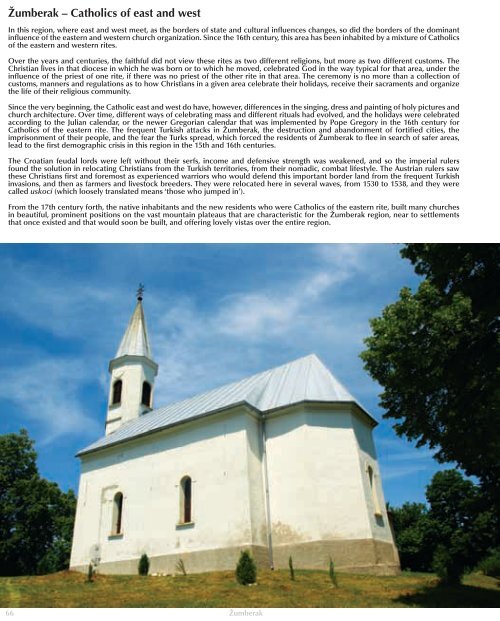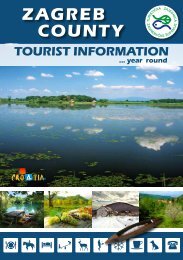The Cultural Heritage of Zagreb County
The Cultural Heritage of Zagreb County
The Cultural Heritage of Zagreb County
Create successful ePaper yourself
Turn your PDF publications into a flip-book with our unique Google optimized e-Paper software.
Žumberak – Catholics <strong>of</strong> east and west<br />
In this region, where east and west meet, as the borders <strong>of</strong> state and cultural influences changes, so did the borders <strong>of</strong> the dominant<br />
influence <strong>of</strong> the eastern and western church organization. Since the 16th century, this area has been inhabited by a mixture <strong>of</strong> Catholics<br />
<strong>of</strong> the eastern and western rites.<br />
Over the years and centuries, the faithful did not view these rites as two different religions, but more as two different customs. <strong>The</strong><br />
Christian lives in that diocese in which he was born or to which he moved, celebrated God in the way typical for that area, under the<br />
influence <strong>of</strong> the priest <strong>of</strong> one rite, if there was no priest <strong>of</strong> the other rite in that area. <strong>The</strong> ceremony is no more than a collection <strong>of</strong><br />
customs, manners and regulations as to how Christians in a given area celebrate their holidays, receive their sacraments and organize<br />
the life <strong>of</strong> their religious community.<br />
Since the very beginning, the Catholic east and west do have, however, differences in the singing, dress and painting <strong>of</strong> holy pictures and<br />
church architecture. Over time, different ways <strong>of</strong> celebrating mass and different rituals had evolved, and the holidays were celebrated<br />
according to the Julian calendar, or the newer Gregorian calendar that was implemented by Pope Gregory in the 16th century for<br />
Catholics <strong>of</strong> the eastern rite. <strong>The</strong> frequent Turkish attacks in Žumberak, the destruction and abandonment <strong>of</strong> fortified cities, the<br />
imprisonment <strong>of</strong> their people, and the fear the Turks spread, which forced the residents <strong>of</strong> Žumberak to flee in search <strong>of</strong> safer areas,<br />
lead to the first demographic crisis in this region in the 15th and 16th centuries.<br />
<strong>The</strong> Croatian feudal lords were left without their serfs, income and defensive strength was weakened, and so the imperial rulers<br />
found the solution in relocating Christians from the Turkish territories, from their nomadic, combat lifestyle. <strong>The</strong> Austrian rulers saw<br />
these Christians first and foremost as experienced warriors who would defend this important border land from the frequent Turkish<br />
invasions, and then as farmers and livestock breeders. <strong>The</strong>y were relocated here in several waves, from 1530 to 1538, and they were<br />
called uskoci (which loosely translated means ‘those who jumped in’).<br />
From the 17th century forth, the native inhabitants and the new residents who were Catholics <strong>of</strong> the eastern rite, built many churches<br />
in beautiful, prominent positions on the vast mountain plateaus that are characteristic for the Žumberak region, near to settlements<br />
that once existed and that would soon be built, and <strong>of</strong>fering lovely vistas over the entire region.<br />
66 Žumberak



